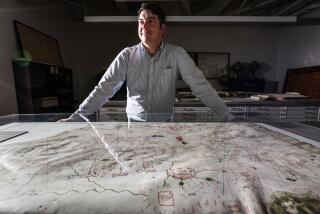Widow Donates 2,500 Maps to Museum
- Share via
In a donation that will quintuple the size of the map collection at the Ventura County Museum of History and Art, the widow of a longtime local engineer plans to give a collection of 2,500 maps of Ventura County that date from 1865 to 1950.
*
“This is the greatest single map donation in the history of Ventura County,” said Charles Johnson, the Ventura museum’s librarian-archivist. “Think about the fact that we have 500 maps and the amount of time it took to acquire those maps. And we’re now about to acquire 2,500 maps all at once. It’s really a gold mine.”
The donor, Ventura resident Sharon Hale, said she made the gift in memory of her husband. Civil engineer T. William (Bill) Hale died of a brain aneurysm in December at 60.
In 1967, Bill Hale became the first director of public works for the city of Thousand Oaks and later worked as a civil engineer throughout the county.
“What a great way to give a memorial to his work, and the (civil engineers) before and after him,” Sharon Hale, 51, said Friday. “It deserves to have the public view. . . . It’s like looking into the eyes of your grandparents or great-grandparents.”
This view into county pioneers’ history is potentially valuable in the financial sense as well. Hale estimates that the maps could be worth as much as $250,000.
The maps provide detailed and extensive glimpses into the history and growth of both the east and west county. Nearly all were drawn by hand, many on linen or linen-backed paper.
One 1898 map of the Burson Rancho details the numbers of acres of particular crops planted on a ranch in the Ventura area--12 1/2 acres of oranges and lemons, so many acres of apricots, prunes, grain and alfalfa.
Another turn-of-the-century relief map of the mountains of Rancho el Conejo, which later became Thousand Oaks, is painstakingly realized. Innumerable tiny hash marks stand out against the blue paper to form the mountains’ outline. Erasure marks, leaving behind shades of white, denote the contours and elevation.
Of Hale’s gift, Johnson said effusively: “It’s overwhelming, generous in the extreme.”
Other librarians were ecstatic about what Johnson delightfully termed “a coup.”
“Wow!” exclaimed Anthony Bliss, a rare-book librarian for the Bancroft Library in Berkeley, recognized as one of the finest libraries in the world. “This is an absolute boon for local historians. Maps are so rich in information. . . . You have information on population, on agriculture, economics, geology and land use. This is a gold mine.”
*
“Maps like this are extremely valuable, especially in areas of land use,” said state Librarian Kevin Starr after being told of Ventura County’s windfall.
Hale said the maps will be moved from Robert Martin & Associates, where they have been for more than 40 years, to the museum on April 26. Her husband bought the firm, along with the maps, in 1991 and she didn’t even know about them until last September, when she began to help out at the office after a secretary fell ill.
“When you work with money, for example, it becomes just a piece of paper after awhile,” said Hale, vice president and corporate secretary of First State Bank of the Oaks in Thousand Oaks until it was sold last April. “And that’s what happened (at her husband’s firm). The maps would just take care of what needed to be done for that job.”
Johnson said that once he and his staff receive the maps, they will begin the daunting task of cataloguing them, and then the public can begin to pore over them.
The maps should start appearing in the library’s catalogue in the next six to 12 months, he said.
It has been a banner year for the museum, Johnson said, noting a recent donation from the Bank of A. Levy--a trove of historical artifacts ranging from financial ledgers to a hand-painted shaving mug the founder kept at the Oxnard barbershop he visited daily.
And for Hale, the gift is a concrete way to honor her husband by passing on the rich, historic legacy contained in the maps. “They should be seen. They should be available to the public,” she said. “I definitely feel it would be a shame to leave them where nobody else can enjoy them as much as I have.”
More to Read
Sign up for Essential California
The most important California stories and recommendations in your inbox every morning.
You may occasionally receive promotional content from the Los Angeles Times.













